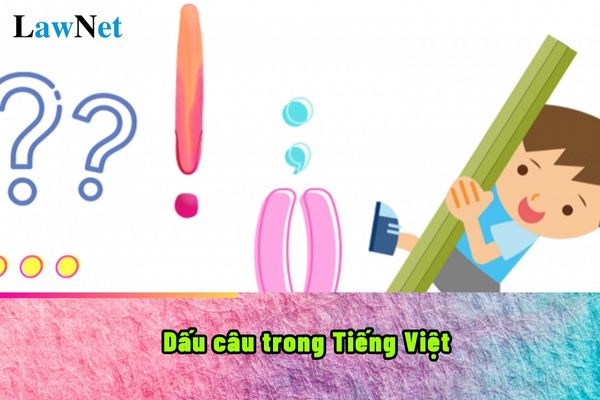What are regulations on punctuation in Vietnamese?
What are regulations on punctuation in Vietnamese?
Vietnamese has a rather rich punctuation system, which helps to make sentences clear, coherent, and precisely convey meaning.
|
Punctuation in Vietnamese [1] Period (.) [2] Question mark (?) |
*Note: Information is for reference only./.

What are regulations on punctuation in Vietnamese? (Image from the Internet)
When do students in Vietnam learn about punctuation in the language knowledge program?
Based on Section V Appendix of the Literature Education Program issued together with Circular 32/2018/TT-BGDDT, the knowledge in the teaching curriculum is as follows:
- The knowledge streams of Vietnamese
+ Phonetics and script: sounds, letters, tonal marks, spelling rules (only taught in elementary school).
+ Vocabulary: expanding vocabulary, word meanings, and usage, word formation, semantic relationships among words.
+ Grammar: punctuation, parts of speech, phrase structure, and sentence structure, sentence types and usage.
+ Communication activities: rhetorical devices, paragraphs, texts, and text types, some issues about linguistic style and pragmatics.
+ The development of the language and linguistic variations: borrowed words, new words and new meanings of words, Vietnamese script, linguistic variations distinguished by geographic, social, and functional scopes, including multimodal texts (language combined with images, signs, data, charts, diagrams,...) as a variant of linguistic communication.
- Additionally, the knowledge streams of Vietnamese at each educational level are distributed as follows:
+ Elementary level: some basic understanding of phonetics, script, vocabulary, grammar, communication activities, and linguistic variations (language combined with images, data); the ability to recognize and initially understand related linguistic phenomena and apply them in communication.
+ Lower secondary level: basic understanding of vocabulary, grammar, communication activities, language development, and linguistic variations (local dialects, social dialects; language combined with images, data, charts, diagrams) helps students to comprehend related linguistic phenomena and apply them in communication.
+ Upper secondary level: Some advanced understanding of Vietnamese helps students comprehend, analyze, and initially evaluate related linguistic phenomena, emphasizing creative expression and using language in research reports and communication.
Thus, punctuation is a part of Vietnamese language knowledge included in the 2018 general education program.
What are the characteristics of the Vietnamese language subject in the current teaching program?
Based on Section V Appendix of the Literature Education Program issued together with Circular 32/2018/TT-BGDDT, the characteristics of the Vietnamese language subject in the teaching program are as follows:
Literature is a subject under the field of Language and Literature Education, taught from grade 1 to grade 12. At the elementary level, this subject is called Vietnamese; at the lower and upper secondary levels, it is called Literature.
Literature is a subject with instrumental and aesthetic - humane properties; it provides students with communication tools, forming a basis for studying all other subjects and educational activities in school; simultaneously, it is a crucial tool for educating students about the noble values of culture, literature, and the national language; fostering healthy emotions, humane feelings, altruistic lifestyle,...
Through verbal texts and vivid artistic images in literary works, by reading, writing, speaking, and listening activities, Literature plays a crucial role in helping students form and develop good qualities as well as core competencies to live and work effectively and to engage in lifelong learning.
The content of Literature is comprehensive, encompassing knowledge of culture, ethics, philosophy,...related to many other subjects and educational activities such as History, Geography, Arts, Civic Education, Foreign Languages, Natural and Social Sciences, Experiential Activities, Career-oriented Activities,... Literature also closely relates to life itself; it helps students be more concerned and connected with everyday life, and be able to relate and have the skills to solve arising problems in practice.
The core content of the subject includes basic and essential knowledge and skills in Vietnamese and literature, meeting the achievement requirements of students' qualities and competencies at each educational level; it is divided into two phases: basic education phase and career-oriented education phase.
Basic education phase: The program is designed according to the main knowledge streams corresponding to the skills of reading, writing, speaking, and listening. Vietnamese and literature knowledge is integrated into the teaching process of reading, writing, speaking, and listening. The materials are selected and arranged according to the students' reception ability at each educational level. The objective of this phase is to help students use Vietnamese fluently to communicate effectively in life and study well in other subjects and educational activities; form and develop literary competence, an expression of aesthetic competence; and simultaneously foster thoughts, emotions to develop students' souls and personalities.
Career-oriented education phase: The program consolidates and develops the outcomes of the basic education phase, helping students enhance their linguistic and literary competence, especially in understanding literary texts; strengthen skills in creating argumentative texts and informational texts that are more complex in content and writing techniques; provide some historical and theoretical literary knowledge practical for reading and writing about literature; continuing to foster thoughts, emotions, soul, and character to make students responsible citizens. Additionally, each year, students oriented towards social sciences and humanities can choose to study some specific learning topics. These topics aim to enhance knowledge about literature and language, skills in applying knowledge into practice, meeting students' interests, needs, and career orientations.
Thus, the distinctive characteristic of the Vietnamese language subject in the teaching program is it is called Vietnamese language in the primary level and Literature in the lower and upper secondary level.

